Sunday, April 25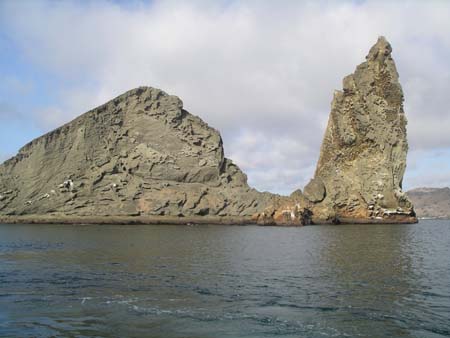
Steve: Today's program began with a wonderful excursion on the tiny Bartholomew Island, located just off the coast of Santiago Island. This is an uninhabited island with a desolate, rocky surface and numerous volcanic formations that give it almost a lunar feel. The island has been formed by volcanic eruptions under the sea and the resulting accumulation of volcanic material that has occurred over time. Bartholomew is also home to "Pinnacle Rock", one of the most photographed formations in all of the Galapagos Islands.
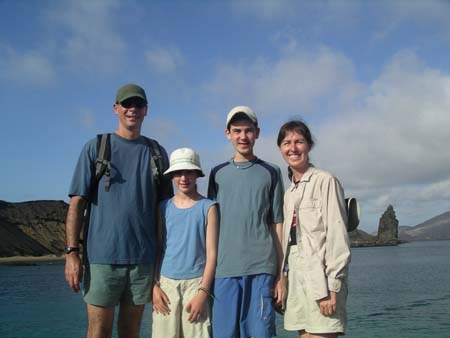 We
started with a dinghy ride along the coast, where it was possible to see several
sea lions, American oyster catchers, marine iguanas and blue-footed boobies.
We also watched as Pacific green turtles swam along the surface. We were on
the lookout for the Galapagos
We
started with a dinghy ride along the coast, where it was possible to see several
sea lions, American oyster catchers, marine iguanas and blue-footed boobies.
We also watched as Pacific green turtles swam along the surface. We were on
the lookout for the Galapagos 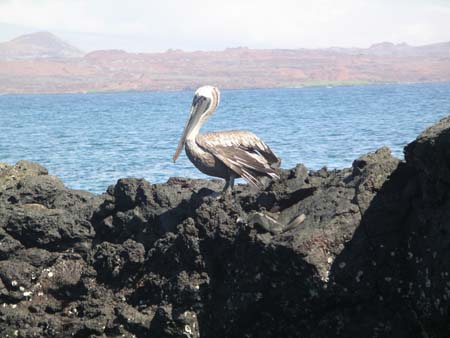 penguin,
the only penguin found north of the equator, and the second smallest in the
world (the smallest are actually the blue penguins that we saw in New Zealand).
Although we didn't see any penguins during our dinghy ride, we were thrilled
to see one in the water during our snorkel (more on that later).
penguin,
the only penguin found north of the equator, and the second smallest in the
world (the smallest are actually the blue penguins that we saw in New Zealand).
Although we didn't see any penguins during our dinghy ride, we were thrilled
to see one in the water during our snorkel (more on that later).
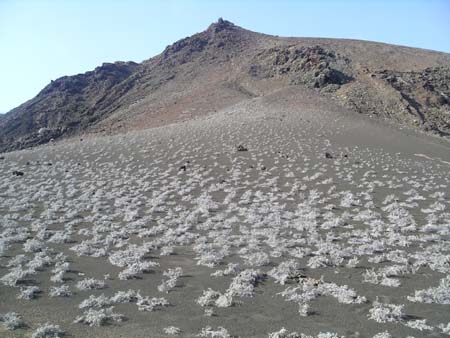 After
circling the island, we began a hike to the highest point on Bartholomew,
located 400 feet above sea level and providing a wonderful panoramic view
including several neighboring islands. The
After
circling the island, we began a hike to the highest point on Bartholomew,
located 400 feet above sea level and providing a wonderful panoramic view
including several neighboring islands. The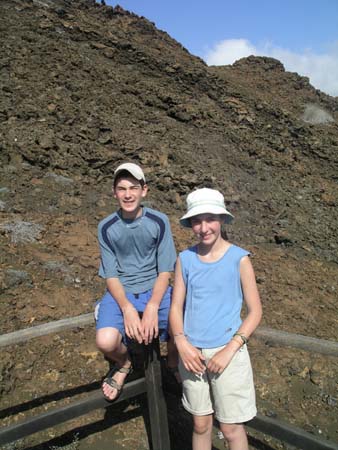 landscape here is truly spectacular and unlike anything we have ever seen
before. The entire island is covered with unique volcanic formations, and
reminded us of the descriptions given by several of the islands' first explorers
who spoke about the Galapagos' harsh, arid and inhabitable environment.
landscape here is truly spectacular and unlike anything we have ever seen
before. The entire island is covered with unique volcanic formations, and
reminded us of the descriptions given by several of the islands' first explorers
who spoke about the Galapagos' harsh, arid and inhabitable environment.
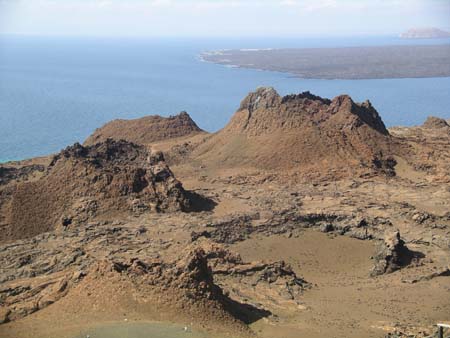 Ecuador's
national park service has constructed a wooden walkway to prevent erosion
of the fragile landscape, and as we hiked up the path our naturalist explained
much about the spectacular volcanic formations that we could see all around
us. Most interesting
Ecuador's
national park service has constructed a wooden walkway to prevent erosion
of the fragile landscape, and as we hiked up the path our naturalist explained
much about the spectacular volcanic formations that we could see all around
us. Most interesting 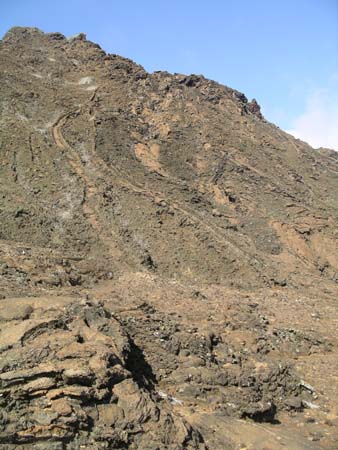 were
the multiple volcanic cones (four of which are visible in this picture on
the left), many still in tact, that are evidence of the huge submarine eruptions
that have occurred here. In several spots, we could see where the actual lava
once flowed in rivers down the slopes of the island. We also
were
the multiple volcanic cones (four of which are visible in this picture on
the left), many still in tact, that are evidence of the huge submarine eruptions
that have occurred here. In several spots, we could see where the actual lava
once flowed in rivers down the slopes of the island. We also 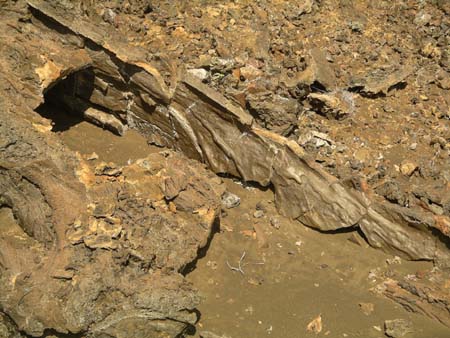 examined
a small "lava tube" (pictured here on the left), the sides of which
are coated with formations of lava that appear as dried drips, frozen in time.
We learned that some lava tubes in the Galapagos are actually large enough
to walk through.
examined
a small "lava tube" (pictured here on the left), the sides of which
are coated with formations of lava that appear as dried drips, frozen in time.
We learned that some lava tubes in the Galapagos are actually large enough
to walk through.
 As
we reached the top of the trail, we were rewarded with a wonderful 360-degree
view. We were able to look down on Bartholomew's scattered volcanic cones,
across to neighboring Santiago Island and out to several other islands in
the distance. Pinnacle Rock, one of the landmark formations of the Galapagos
Islands, was located directly in front of us, providing a dramatic component
to the scene.
As
we reached the top of the trail, we were rewarded with a wonderful 360-degree
view. We were able to look down on Bartholomew's scattered volcanic cones,
across to neighboring Santiago Island and out to several other islands in
the distance. Pinnacle Rock, one of the landmark formations of the Galapagos
Islands, was located directly in front of us, providing a dramatic component
to the scene.
Bartholomew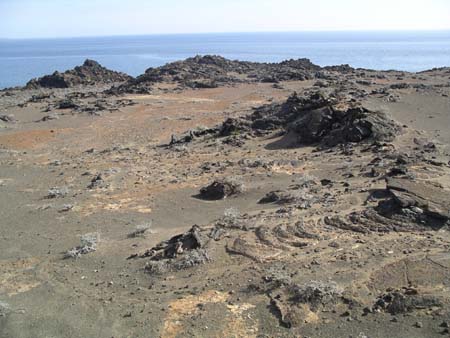 is traditionally a very popular destination in the Galapagos Islands, and
because of its small size and fragile environment, the national park service
has had to carefully regulate the number of visitors here. It's best known
for its wonderful geologic formations, but we also saw some wildlife living
in this desolate environment including lava lizards, Sally Lightfoot crabs,
turtles and of course sea lions.
is traditionally a very popular destination in the Galapagos Islands, and
because of its small size and fragile environment, the national park service
has had to carefully regulate the number of visitors here. It's best known
for its wonderful geologic formations, but we also saw some wildlife living
in this desolate environment including lava lizards, Sally Lightfoot crabs,
turtles and of course sea lions.
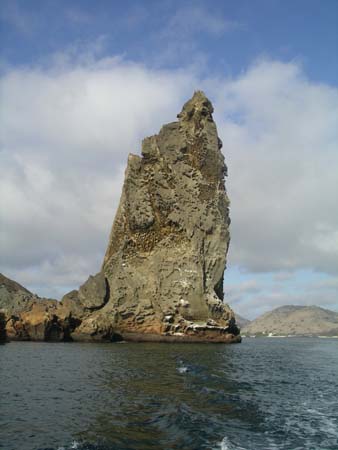
After our hike, we had a fantastic snorkel in the small bay located alongside Pinnacle Rock. Our hopes of seeing some unique marine animals quickly became reality as we immediately encountered two baby spotted eagle rays swimming in the shallow surf. David and I were then thrilled to find a lone Galapagos penguin swimming among large schools of fish directly below us. Katie and Paula joined, and we all delighted in watching the penguin swoop repeatedly through the fish at full speed (it appeared to us as though he was trying to catch a meal), circle around us, and then come to the surface directly in front of our masks. He performed this cycle multiple times, seemingly oblivious to our presence. He was much more business-like than the playful sea lion that we encountered yesterday, and it was wonderful to watch him for several minutes as he darted through the water.
We snorkeled around Pinnacle Rock, through narrow caverns filled with large schools of fish, and then headed across the bay toward the rock formations on the other side of the beach. Along the way, we spotted our first turtle, a beautiful large Pacific green turtle that was swimming lazily along the bottom. We followed him for a few minutes, and then continued to the other side of the bay where we found more large schools of colorful fish. Our final sightings included a spotted eagle ray, and an octopus (the first one we've ever seen in the wild!). David was actually the one who found the octopus, which was amazing considering how well camouflaged it was as it fed on the bottom among patches of seaweed. As we headed back to the ship, we all agreed that any snorkel that includes seeing a penguin, a turtle, multiple spotted rays and an octopus has to qualify as a huge success!
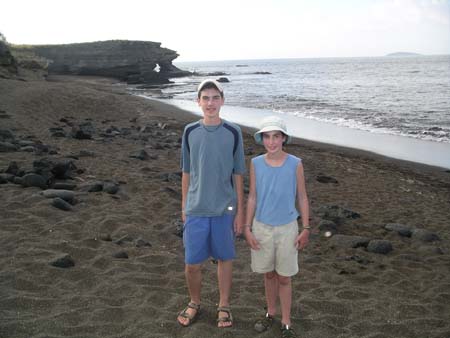 This
afternoon found us at Santiago Island, also called James Island (all of the
islands here have both Spanish and English names). We disembarked at an area
called Port Egas on a black lava beach. Paula and I had been on a black sandy
beach before on St. Kitts in the Caribbean, but this was David and Katie's
first time seeing a beach like this. However, we certainly didn't want to
linger too long on shore, and quickly put on our snorkeling gear for another
view of Galapagos' amazing marine life.
This
afternoon found us at Santiago Island, also called James Island (all of the
islands here have both Spanish and English names). We disembarked at an area
called Port Egas on a black lava beach. Paula and I had been on a black sandy
beach before on St. Kitts in the Caribbean, but this was David and Katie's
first time seeing a beach like this. However, we certainly didn't want to
linger too long on shore, and quickly put on our snorkeling gear for another
view of Galapagos' amazing marine life.
Never would we have expected the thrill of seeing so many large sea turtles at such close range. We counted seven turtles in total, several of which were very large females. Unlike other turtles that we've seen while snorkeling (both yesterday on Bartholomew Island and in the Caribbean), these were totally unafraid of us and allowed us to swim with them for as long as we wanted. We stayed with one particularly large turtle as she fed on plants in very shallow water. At one point I stood directly in front of her, and she swam directly into my flippers, never turning away. We watched in amazement as another turtle was swarmed by a group of fish that was feeding off the algae on its shell. We had a wonderful time!
David spotted two large white-tip reef sharks that we had heard frequented
these waters. None of the rest of us saw them, but others in our group did.
Paula in particular was very happy when we left the water today…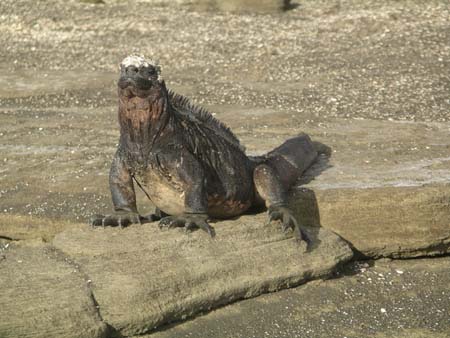
After snorkeling, we took a hike along the shore to view wildlife and learn
more about the geologic history of the islands. Historically, there have been
many attempts by people to settle on Santiago, but these have all failed because
of the remoteness of the island. There are some abandoned salt mines here,
and this is one of the only uninhabited spots where the national park service
allows recreational activities - we learned this as we watched several members
of our crew disembark for a game of football (soccer). Santiago was also one
of Darwi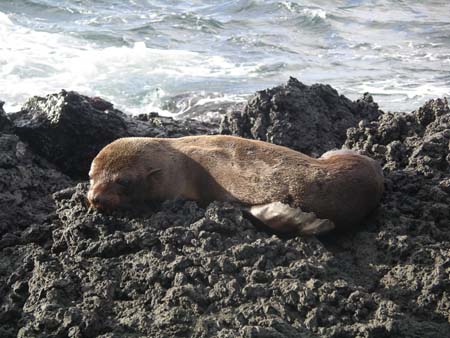 n's
principal laboratories - he spent a total of 9 days here (out of a total of
5 weeks spent among the Galapagos Islands).
n's
principal laboratories - he spent a total of 9 days here (out of a total of
5 weeks spent among the Galapagos Islands).
We saw some new wildlife, including the endemic Galapagos sea lion (pictured
here on the left), one of two types of sea lions found here (the other species
is called the "common sea lion"). The endemic variety is harder
to see, and is recognizable by its rounded nose and thick fur. These animals
are often mistakenly called "fur seals", and in fact there are no
seals in the Galapagos Islands (sea lions have external ears while seals do
not). 
Our other sightings included a Galapagos Hawk that preys on the plentiful
iguanas, lizards and crabs. It's considered the top natural predator in all
of the islands. We also saw a Darwin finch and a mockingbird, and learned
that these are two of only a handful of land birds that can be commo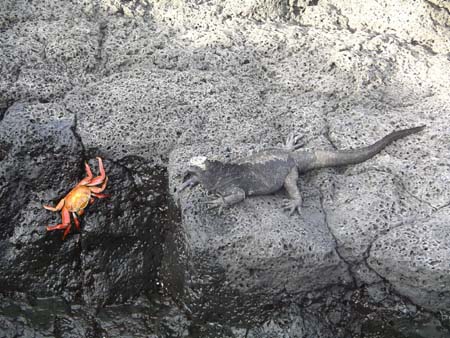 nly
seen here. Most of the other birds were severely hunted by explorers, and
the survivors have moved far inland into the highlands.
nly
seen here. Most of the other birds were severely hunted by explorers, and
the survivors have moved far inland into the highlands.
Our hike ended at an area called "The Grottos", where we watched several sea lions play in tidepools. The area was also filled with black marine iguanas and Sally lightfoot crabs. We also were able to get close to a yellow-crowned night heron (pictured above on the right), which was a somewhat unusual sighting since these birds are primarily nocturnal.
Tomorrow we will head toward the western edge of the archipelago, visiting the islands of Fernandino and Isabela.
Katie's Kwick Kwacks: My experience swimming with marine life. It was a whole new world-completely unreal. There I was swimming in the ocean, face to face with a wild sea lion. It was much bigger than I am. I didn't know where I was or how I got there, but none of that mattered now. I just needed to follow it. The beautiful animal darted towards my mask, blew bubbled and splashed me, then swam just under my legs. Its eyes showed nothing but curiosity and playfulness. The sea lion then spun its majestic body around and around, and swam in circles around me. Its agile and slender body just missed my own. The animal's slick skin glowed in the florescent evening sun. After a moment of shock, I realized what this was all about. I knew why this creature was here, creating one of the most amazing scenes in my life. This sea lion wanted to play.
When I'm in the water with animals, I feel almost in a different consciousness. Marine life seems to have a very special harmony, and snorkeling here in the Galapagos Islands has allowed me to be a part of that. Because of the unique tameness of the aquatic animals here, I have been able to play with sea lions, watch wild penguins feed, and even swim right beside giant sea turtles the size of me. These have been truly remarkable experiences, and occur only in the Galapagos Islands.
I only dreamed of being able to watch a penguin dart after a school of a
thousand fish. Here, I was in the middle of the scene! I also never imagined
being able to swim with giant sea turtles. They let me swim right beside them
and admire their beastly beauty. I could have clung onto their shell without
a problem! It was amazing to be with such magnificent and gigantic creatures,
while feeling like I was part of their environment and world. I felt like
I was just another sea creature, and that's how all of these animals seemed
to view me. I was no longer a stranger in this place--I was part of the ocean
harmony.
Being a part of the ocean harmony has given me a sense of security while I'm
swimming in these unknown waters. When I'm with these gentle animals, I feel
like they'll mentally protect me from any harm. I feel accepted into their
community. I am afraid of sharks, and know that they're there. When I'm in
the midst of this magic, however, I feel like they too are a part of this
harmony, and should be accepted in the same way. I feel safe and secure-no
longer a stranger in this aquatic world.
David's Daily Dump: Our amazing snorkeling day. Yesterday I had the most incredible snorkeling adventure of my life. Yes, it was even better than the Great Barrier Reef in terms of marine life. We swam with a penguin, followed a huge Green Sea Turtle, admired a spotted ray, and even spotted a beautiful octopus! It was an absolutely fantastic experience.
I was really excited as we jumped off our small dingy and raced to get our snorkeling gear on near Pinnacle Rock on Bartholomew Island. We had heard that this was one of the best snorkeling spots in the archipelago, and that we had a chance of seeing the Galapagos Penguins or Sea Turtles.
One of the first things we spotted in the water were two tiny rays, which seemed to fly in the water as we approached them. We only had time to admire them for a minute before they took off. Then we started off into the deeper water where we saw huge schools of small fish so dense that it was tough to see the bottom. Big volcanic rocks jetted out before us as we swam and patches of coral hummed with colorful fish. It was then that I caught my first glimpse of the only penguin to nest in the Northern Hemisphere: The endemic Galapagos Penguin.
The small penguin rocketed through a giant school of fish right under me, twisting and turning this way and that trying to capture his lunch. I practically did somersaults in the water trying to get a picture. He was so cool! After about a minute of watching him, he zoomed to the surface and filled his lungs. He hung out on the surface for a while before he started off again. He always swam right beside us as if he was using us as a barrier to coral the fish. After watching him for several minutes, we started swimming toward the famous Pinnacle Rock.
Snorkeling around this massive pointed volcanic rock was awesome. There were lots of colorful fish swimming around the coral, and huge parrot fish munched on the algae. Some parts of the water were shaded by the rock which made you feel like you were snorkeling into a cave or deep water. After watching the life around the rock, we headed to the other side of the beach where we had seen sea turtles earlier on our dingy ride. And sure enough, we found exactly what we were looking for.
There, cruising on the ocean floor, was a gargantuan Green Sea Turtle. We were able to snorkel right above him while going snapshot crazy. His shell was magnificent. It looked almost like a green tie-dyed shirt with amazing shades of light green and aqua. We followed him until he was out of sight, and then we headed off to shore.
On our way back to the shore, we came across two other magnificent sea creatures. The first one we spotted was a spotted eagle ray, sitting on the bottom waiting for a fish to pass by. He was covered in small white spots with a long pointed tail. We admired him for a while before continuing our journey back to shore where we met a very unusual creature that we have never seen in the wild before…
We were swimming over a big path of seaweed when suddenly I caught a glimpse of something that moved just a little bit in the weed. I thought it was nothing at first, but when I took another look, I saw two little eyes poking out before me. Then I noticed many legs squirming around, each with tentacles on the bottom. I took my head out of the water and screamed, "Octopus!"
This creature was camouflaged so well that even though I only took my eyes off it for a split second, I could no longer see it in the water. The rest of the family rushed over to me, and couldn't see it either. Then after a few minutes of scanning the bottom, I spotted him again, in the same place where I had first seen him. He was so cool! I had never seen an octopus before, neither had my dad. Everyone couldn't believe that I had seen him because of how much he looked like a patch of weed! He was brownish black and about the size of a soccer ball. All of his legs were rummaging in the seaweed, trying to catch small fish.
We all started to get our cameras, and we all lost him…again! No matter how hard we looked, we still couldn't see him. It was amazing! After a while he moved again, and we got our pictures. We went back to the beach with smiles on our faces and not a single picture left on all four of our underwater cameras!
This was an unbelievable experience for me and the rest of my family. It really gave us a taste of how unique the Galapagos Islands are, and how terrible it would be if all it was lost due to human destruction.
